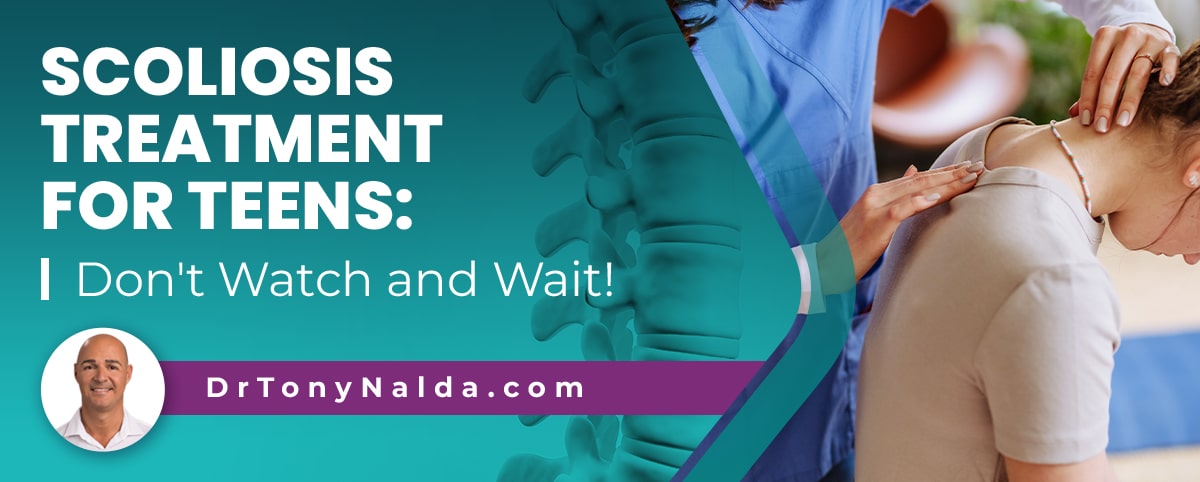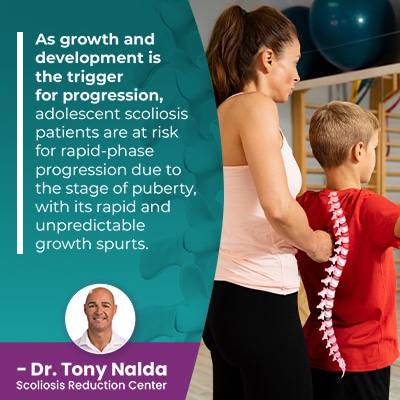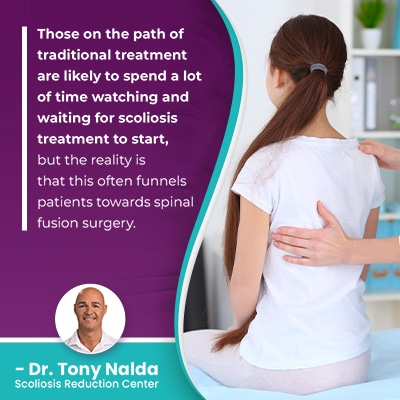Scoliosis Treatment For Teens: Don't Watch and Wait!

There are different ways to treat scoliosis, both surgically and non-surgically, and each offers patients a different potential result. It's important for parents of teens, and the patients themselves, to understand why a passive watch-and-wait approach can be dangerous; continue reading to find out why.
When it comes to scoliosis treatment for teens, the best time to start is always now. As a progressive condition, scoliosis only gets more complex to treat as it gets worse, and growth is the condition's main trigger.
Scoliosis ranges widely in severity and is a highly-prevalent structural spinal condition, so let's start with how it's diagnosed.
Table of Contents
How is Scoliosis Diagnosed?
Scoliosis involves the development of an unnatural side to side curve that also rotates, making it a complex 3-dimensional condition.
There are many different types of spinal conditions that cause a loss of its healthy curves, but the rotational component sets scoliosis apart, and in addition, a scoliotic curve has to be of a minimum size to be diagnosed as scoliosis: Cobb angle measurement of at least 10 degrees.
A patient's Cobb angle is a key part of the diagnostic and assessment process because it tells me how severe a condition is:
- Mild scoliosis: Cobb angle measurement of between 10 and 25 degrees
- Moderate scoliosis: Cobb angle measurement of between 25 and 40 degrees
- Severe scoliosis: Cobb angle measurement 40+ degrees
- Very-severe scoliosis: Cobb angle measurement of 80+ degrees
A patient's Cobb angle is determined during X-ray by drawing lines from the tops and bottoms of the curve's most-tilted vertebrae, and the resulting angle is expressed in degrees.
When it comes to the different types of scoliosis, we're talking about different causes and treatment needs.
Scoliosis affects all ages, and the most common type of scoliosis to affect both children and adults is classified as idiopathic scoliosis: not associated with a single-known cause.
Idiopathic scoliosis accounts for approximately 80 percent of known diagnosed scoliosis cases, and the remaining 20 percent are associated with known causes: neuromuscular scoliosis, degenerative scoliosis, and congenital scoliosis.
The most common form of scoliosis overall is adolescent idiopathic scoliosis, diagnosed between the ages of 10 and 18.
The diagnosis of scoliosis is reached through a physical examination that includes taking the patient's medical and family history, performing an Adam's forward bend test where the patient stands in front of me and bends forward at the hips (spine is highly visible in this position).
If my examination finds condition indicators, further evaluation through a follow up examination and an X-ray is ordered to truly see what's happening in and around the spine.
To address why watching and waiting is a risky treatment approach, we need to explore the condition's progressive nature.
Scoliosis is Progressive
 When it comes to scoliosis treatment options, the most important condition-characteristic to understand is its progressive nature.
When it comes to scoliosis treatment options, the most important condition-characteristic to understand is its progressive nature.
Progressive conditions have it in their nature to worsen over time, particularly if left untreated, or not treated proactively.
When talking about adolescent idiopathic scoliosis treatment, patient age is key because although we don't fully understand what triggers the onset of adolescent idiopathic scoliosis, we most certainly know what makes it progress: growth.
The more growth potential a patient has, the more potential progression is likely forthcoming; curve progression means the unnatural spinal curve is going to get larger, and this means the condition's uneven forces are going to increase, as are their effects.
As growth and development is the trigger for progression, adolescent scoliosis patients are at risk for rapid-phase progression due to the stage of puberty and its rapid and unpredictable growth spurts.
So, again, for patients with significant growth remaining, progression is virtually guaranteed, and in these cases, while monitoring for progression is part of treatment, active treatment with corrective results as the end goal should also be applied, but this will depend on whether a patient is on the path of traditional or conservative scoliosis treatment.
Traditional Scoliosis Treatment Options
Those on the path of traditional treatment are likely to spend a lot of time watching and waiting for scoliosis treatment to start, but the reality is that this often funnels patients towards spinal fusion surgery.
Treating scoliosis with surgery isn't always necessary, and it is an invasive procedure that involves fusing the most-tilted vertebrae of the unnatural spine curvature into one solid bone and attaching metal rods with pedicle screws to the spine to hold it in place; this is contrary to the spine's movement-based design and has the goal of stopping progression.
If a teen is diagnosed with mild scoliosis and they are undergoing traditional treatment, they will be told merely to watch and wait because traditional treatment doesn't have a strategy for treating scoliosis while mild; to me, this is wasting valuable treatment time, and when scoliosis is mild is the best possible time to start treatment, which is why being proactive can be so beneficial, but this is a feature of conservative scoliosis treatment.
Conservative Scoliosis Treatment Options
 Here at the Scoliosis Reduction Center, I apply a conservative chiropractic-centered treatment approach that I start as close to the time of diagnosis as possible.
Here at the Scoliosis Reduction Center, I apply a conservative chiropractic-centered treatment approach that I start as close to the time of diagnosis as possible.
I want to be proactive with treatment, particularly with adolescent idiopathic scoliosis, because scoliosis only gets more complex to treat as it progresses, and while there are no treatment guarantees, early detection, when met with proactive treatment, is associated with treatment success.
As a structural spinal deformity, scoliosis needs to be impacted on a structural level, first and foremost, and I work towards this through a series of condition-specific chiropractic care and manual adjustments that can realign the spine by repositioning the curve's most-tilted vertebrae.
Once I start to see structural results, I can shift the focus to increasing core strength through physical therapy and scoliosis-specific exercises. It's not just the spine that has to maintain its natural curves and alignment; it's also the job of its surrounding muscles.
The use of a corrective brace is known to be particularly effective on growing spines and can help augment a curvature reduction by pushing the spine into a corrective position.
Rehabilitation is the final and ongoing phase of treatment that can involve continued chiropractic care, and a series of custom-prescribed home exercises for further stabilizing and healing the spine
I start treatment as close to the time of diagnosis as possible because this is when the condition is going to be at its mildest and most responsive to treatment.
Conclusion
Scoliosis progression makes scoliosis more complex to treat, and when we're talking about teens with scoliosis, we know they are at risk for rapid-phase progression due to growth spurts.
There was a time when mandatory school screening for scoliosis was in place, but that has since changed, meaning that parents, and patients themselves, need to recognize the condition's early signs to achieve early detection; these are often uneven shoulders, hips, and the development of rib hump (rib cage arch).
Early detection of adolescent idiopathic scoliosis isn't always easy to achieve because as scoliosis doesn't become a compressive condition until skeletal maturity has been reached, significant pain isn't a common part of the adolescent experience, while back pain is the main symptom of adult scoliosis.
Small curves are easier to treat than large curves, which is why starting treatment while a condition is mild can be so beneficial, and when it comes to long term outcomes, a scoliosis treatment approach that preserves as much of the spine's natural curves and function is best.
Most teens, particularly those diagnosed with minor scoliosis, don't require scoliosis surgery; while there is still a place for scoliosis surgery as a form of treatment, it is an invasive procedure that can impact the entire spine and how it functions.
The primary goal of traditional treatment is to stop progression, while the main goal of conservative treatment is to achieve corrective results.
If a teen is diagnosed with adolescent idiopathic scoliosis, don't watch and wait. Don't hesitate to start treatment because as a progressive condition, it's virtually guaranteed to get worse at some point, so merely watching and waiting while a patient's scoliosis is allowed to progress unimpeded is wasting valuable treatment time.
As the spine gets more rigid with progression and less responsive to treatment, it can be dangerous to not act, particularly as a child grows, as growth is the main trigger for an increasing curve size.
It's far more effective to proactively work towards preventing progression and increasing condition-effects than it is to attempt to work towards reversing those effects once they're established.
Here at the Center, I take an adolescent child's treatment for scoliosis very seriously because not only are adolescents at risk for rapid-phase progression, many patients also at risk for needing invasive spinal surgery in the future.
With the Scoliosis Research Society putting current estimates at close to seven million people currently living with scoliosis in the United States alone, it's a highly-prevalent spinal condition that warrants awareness so its early symptoms can be recognized.
Dr. Tony Nalda
DOCTOR OF CHIROPRACTIC
After receiving an undergraduate degree in psychology and his Doctorate of Chiropractic from Life University, Dr. Nalda settled in Celebration, Florida and proceeded to build one of Central Florida’s most successful chiropractic clinics.
His experience with patients suffering from scoliosis, and the confusion and frustration they faced, led him to seek a specialty in scoliosis care. In 2006 he completed his Intensive Care Certification from CLEAR Institute, a leading scoliosis educational and certification center.
About Dr. Tony Nalda
 Ready to explore scoliosis treatment? Contact Us Now
Ready to explore scoliosis treatment? Contact Us Now





